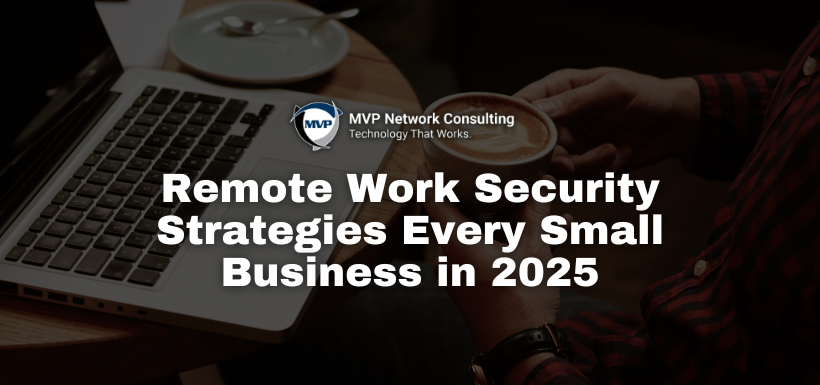Remote Work Security Strategies Every Small Business Needs in 2025

Ikram Massabini
July 22, 2025

Remote work isn’t just a trend anymore—it’s become a standard business model for many small and midsize companies. What started as a temporary response to a global crisis has now become a competitive advantage for attracting top talent, streamlining operations, and expanding reach.
But with that flexibility comes risk. The digital workplace of 2025 introduces new vulnerabilities, from home office networks to cloud apps and mobile devices. Outdated protocols and “good enough” security are no longer sufficient. If you want to stay secure, compliant, and operational, your security strategy must match the pace of evolving cyber threats.
This guide outlines the most important remote work cybersecurity upgrades you should consider this year to keep your business and employees protected.
What Does Remote Work Look Like in 2025?
According to Gartner, over 75% of workers now expect flexible schedules and remote options. That’s great for employee satisfaction—but it adds serious pressure to IT and cybersecurity teams.
As employees log in from home offices, coffee shops, and co-working spaces, businesses are more exposed than ever. New access points create more opportunities for phishing, credential theft, and unauthorized tools that could leave your business vulnerable.
Modern remote security is no longer about locking down devices—it’s about building a resilient, intelligent security framework that adapts in real time.
Proven Strategies to Secure Remote Work in 2025
Security for remote and hybrid teams requires layered protection, smarter tools, and proactive monitoring. Here are seven strategies to implement now.
#1 Strengthen Your Network with Zero Trust
Zero Trust assumes no user or device should be trusted by default—even inside your network.
How to get started:
Require multi-factor authentication (MFA) for all accounts.
Use identity management tools like Okta or Azure AD to enforce role-based access and geolocation rules.
Monitor user activity continuously and flag any suspicious behavior.
#2 Protect Devices with Advanced Endpoint Detection and Response (EDR)
Traditional antivirus tools aren’t enough. EDR systems go beyond simple scans—they monitor device behavior in real time and respond to threats automatically.
Next steps:
Choose an EDR platform with AI-driven detection and auto-remediation features.
Run threat simulations to test your defenses.
Integrate EDR with your overall security stack for centralized monitoring.
#3 Move Beyond VPNs with Smarter Secure Access Tools
VPNs have their place, but they’re not built for today’s flexible teams. Modern solutions offer greater speed, control, and security.
Consider:
Software-Defined Perimeter (SDP) solutions for granular access control.
Cloud Access Security Brokers (CASBs) to monitor cloud apps.
Secure Access Service Edge (SASE) platforms for secure, scalable remote connectivity.
#4 Keep Systems Up to Date with Automated Patching
Unpatched software is one of the most common attack vectors. Automation helps close those gaps before hackers can exploit them.
Use these tactics:
Deploy RMM tools to push updates remotely.
Set up regular patch audits and automated alerts.
Test critical patches in a secure environment before company-wide rollout.
#5 Promote Cyber Awareness with a Security-First Culture
Even the best tools can’t prevent careless mistakes. Building strong employee habits is critical.
Best practices:
Offer short, frequent cybersecurity training.
Run phishing simulations to improve detection.
Write clear, easy-to-follow security policies.
#6 Prevent Data Leaks with DLP Technology
Remote teams often work across multiple devices and platforms. That increases the risk of unintentional data exposure.
Steps to secure your data:
Classify and label sensitive data automatically.
Use DLP tools to monitor and restrict data movement.
Apply access controls based on user role, device, and risk level.
#7 Get Full Visibility with SIEM Tools
A distributed team creates more data points and more potential entryways. SIEM (Security Information and Event Management) platforms provide centralized visibility and smarter threat detection.
What to do:
Aggregate logs from EDR, IAM, cloud apps, and firewalls.
Use AI to detect unusual behavior and auto-respond to threats.
Automate compliance reporting for frameworks like HIPAA, PCI DSS, or GDPR.
Five Extra Tips to Strengthen Your Remote Security Framework
Remote work isn’t going anywhere—and neither are the risks. To stay ahead of evolving threats, your security strategy needs to be agile and comprehensive. Here’s how to build on your foundation:
#1 Create a Unified Security Dashboard
Centralize monitoring across your entire IT ecosystem.
Use SIEM solutions like Microsoft Sentinel or Splunk.
Integrate data from RMM tools, firewalls, EDR, and identity platforms.
Build role-specific dashboards for leadership and compliance teams.
#2 Standardize Identity and Access Controls
Simplify and secure user authentication.
Enable Single Sign-On (SSO) for business tools.
Enforce MFA company-wide.
Use conditional access policies based on device health, behavior, and location.
#3 Use Automation and AI to Respond Faster
Speed matters when it comes to cyber threats.
Automate responses to suspicious activity—like isolating compromised devices.
Set up AI-powered anomaly detection.
Use SOAR (Security Orchestration, Automation, and Response) platforms to coordinate response playbooks.
#4 Schedule Regular Security Reviews and Simulations
Security isn’t static—routine testing keeps you prepared.
Run security audits twice a year.
Conduct simulated attacks to test your defenses.
Adjust training and policies based on recurring risks.
#5 Choose Scalable, Flexible Security Tools
Future-proof your remote security environment.
Invest in modular tools that integrate easily.
Prioritize usability and interoperability.
Focus on cloud-native solutions that support hybrid work models.
Build Resilience for the Long Run
Remote and hybrid work models are here to stay—and they bring significant advantages. But to make them work for the long haul, your cybersecurity approach must be modern, dynamic, and deeply integrated. With tools like Zero Trust, EDR, patch automation, DLP, and SIEM, you can secure your remote workforce while staying compliant and productive.
Get Your Free Third-Party Cybersecurity Evaluation
Book a time on Ikram Jr.’s calendar below to discuss next steps.
